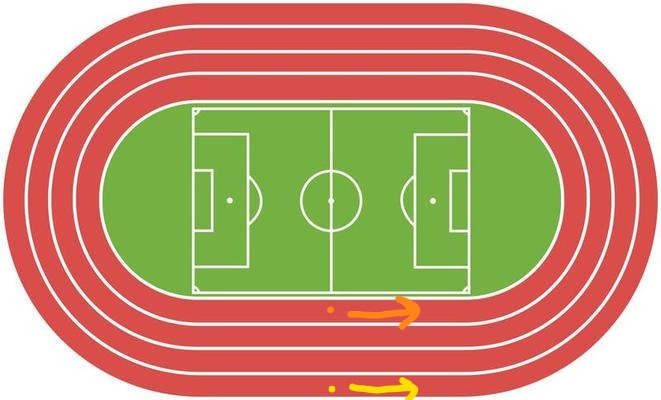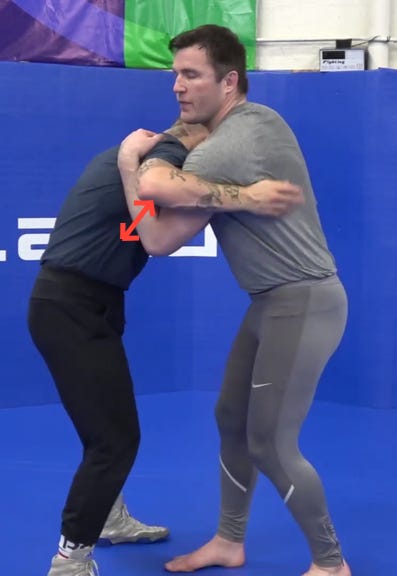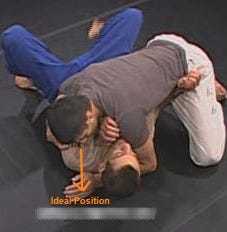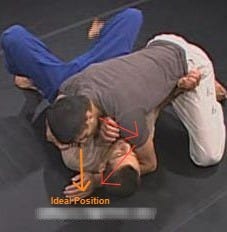What is Inside Position in Brazilian Jiu Jitsu?
Inside position is fundamentally about the control of distance and angle
What is inside position in BJJ?
Definition: Inside position refers to a position in space that occupies the shortest distance between two defined points.
To understand how distance is central to the concept of Inside Position, imagine two people running a 400 metre race on a standard track.
One runner takes the inner most lane relative to the centre of the track, while the other runner takes the outer most lane. Assuming each runner runs at the same speed, the inner most runner would win as geometry tells us that he runs a shorter distance. My definition stipulates having two points in space to refer to which in this case is the centre of the circle and our opponent. Thus we could say that this orange colour coded runner has the inside track position, or simply just the inside position. Owning the inside position means owning the shortest distance between two points.
Some BJJ Examples:
Let's apply this definition to examples from BJJ, firstly
The Underhook
The underhook is widely stated as an example of inside position. We can see that the underhook occupies the space between the side of an opponent's torso relative to their arm. Pretty simple to understand.
The Forearm Frame
Inside position is not strictly about the space between two points of an opponent's body as others (see later) have asserted before.
This frame occupies the space between our upper bodies as seen here. Note that my definition mentions an element of being between the shortest distance between two points and this I feel is significant.
In side control , the top person wants to connect their head as close to the ground beside the bottom person so as to minimise the space available. The forearm in this picture is blocking the shortest path to achieve this goal.
Let's assume the forearm frame stays fixed in space. The top person could take some convoluted route (marked in red) around the frame to get his head to the desired position but this would no longer be the shortest path. If the forearm frame continues to track the top player as they take this longer route, inside position will ultimately be preserved and as the bottom person continues to occupy the shortest distance between the top persons head and their desired destination.
Why is Inside Position So Important?
Inside position has been stressed, emphasised and repeat ad nauseum by every good BJJ instructor at this point but none have pin pointed a fundamental reason as to its importance.
In our examples we have understood the element of distance when we talk about inside position. Control of the inside position is fundamentally about the control of the distance and angle, which is a principle of BJJ. It is constantly stressed and emphasised as highly valuable because it denies an opponent the ability to move in one direction/angle.
Shutting down this path has offensive and defensive implications; it limits an opponent’s offensive options whilst giving you, sometimes unconstrainted offensive options of your own. For an underhook simultaneously provides offensive options like attacking throw-bys to the back whilst also providing defence by denying an opponent the ability to change the angle of the fight and attack your back.
Bonus: Why JordanTeachesJiujitsu is WRONG.
Referenced Video Source: www.youtube.com/watch?v=eYJDb7LZMM
Jordan says and I quote: “Inside position is your torso, as well as everything above your knees, above your elbows, and below your chin”. This is said to accompany the above screenshot wherein the green portions highlight inside position.
This is a problematic definition:
It tells us WHERE inside position can SOMETIMES be not WHAT it is
What about the space below the knees not highlighted in green? Is there no inside position possible in the distance between say our two ankles? Of course there is, seated guard players always look to get their feet inside of ankles as a primary means of connecting to an opponent from bottom. Thus Jordan’s definition is incomplete at best.
Using a singular person’s body as the sole frame of reference.
As you know from my definition, inside position is about being in between two points in space. No where was it specified that the two points need to be on the opponent’s body. This is why I specifically used the forearm frame example earlier to illustrate this point. You don’t even need be connected to another person to control the inside position. Consider the photo below:
The person on the right controls the inside position relative to each of their torsos because he owns the shortest distance between them. He is doing so without any contact whatsoever.
I hope this post has given you a better understanding of what inside position is and I welcome any comments or questions you may have.









